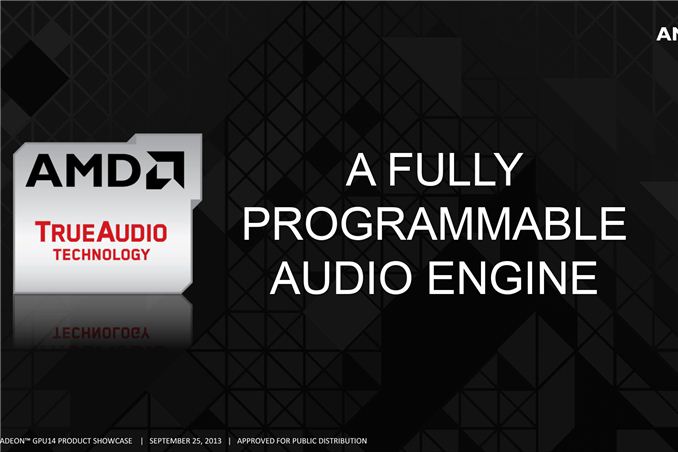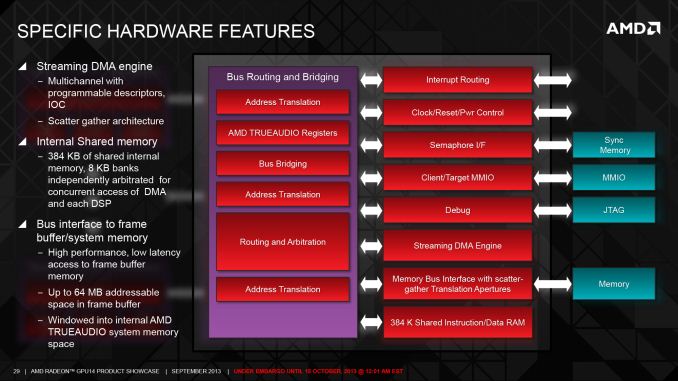PS4 Spec Update: Audio DSP Is Based On AMD’s TrueAudio
by Ryan Smith on November 13, 2013 3:07 PM EST- Posted in
- GPUs
- AMD
- Audio
- PlayStation
- TrueAudio

Continuing our coverage of AMD’s APU13 conference, one of this morning’s keynotes has been from Sony’s VP of Research & Development in North America, Dominic Mallinson. Most of Dominic’s presentation was a recap of the PS4 thus far – including some detail in why Sony went with an AMD APU for the console – but Dominic did throw in one more piece of information on the PS4’s specifications that we haven’t heard before. Specifically, the PS4’s audio DSP is based on AMD’s TrueAudio technology.
Briefly, from a console-centric view this isn’t of great surprise. We’ve had every reason to believe that the PS4’s audio DSP would have similar capabilities to TrueAudio given the features and low die space cost of today’s audio DSPs, coupled with Sony’s previous comments on the matter. So from that perspective this isn’t a significant revelation as far as the PS4’s audio capabilities are concerned, but we do finally have a bit more detail on the underlying hardware powering it.
But from a PC perspective however, this is going to be more important and unexpected news. At this time we don’t know what the underlying API is like – AMD hasn’t even released the TrueAudio PC API yet – but the shared hardware is going to be a big deal for both AMD’s CPUs and APUs. One of the challenges we discussed as facing TrueAudio is developer adoption; AMD has to convince developers to take the time to program for TrueAudio along with more traditional CPU sound engines. AMD has been working with audio middleware developers to help bootstrap TrueAudio adoption, but today’s announcement would take that one step further.
PS4 utilizing TrueAudio means there will be at least some level of audio engine portability between the PS4 and current generation AMD products. To that end if developers can write high quality audio engines on the PS4 thanks to the presence of the dedicated audio DSP, and then take that audio engine and bring it to the PC to run on GPU/APU TrueAudio DSPs, then that provides a further avenue for bootstrapping TrueAudio usage in games. So much like Mantle in the graphics space, a shared console connection for TrueAudio in the audio space would allow for AMD to leverage their console connection to both allow better/easier porting from consoles, and to achieve the critical mass necessary to make tapping these low-level hardware features viable and worthwhile for a wider pool of developers.
That said, AMD isn’t promoting TrueAudio as a console porting solution right now like they have been Mantle, but the potential is there if AMD and developers seek to exploit it. Which if nothing else makes TrueAudio all the more worth keeping an eye on over the next year, as solving the bootstrap/adoption issue will be a critical factor in the technology’s success. On that note, according to AMD’s latest schedule Thief is still expected to be the PC TrueAudio launch title, so we should be getting to see the first fruits of AMD’s labor here in February.


















43 Comments
View All Comments
inighthawki - Thursday, November 14, 2013 - link
How old is your blu ray player? Because unless it's 8 years old like the 360, that's not much of a shocker.djscrew - Thursday, November 14, 2013 - link
# of simultaneous voices seems like an arbitrary metric after... oh say 50.sajara - Thursday, November 14, 2013 - link
imagine you're in virtual mall with over 200 people talking at the same time. it will be... amazing... /o\djscrew - Thursday, November 14, 2013 - link
I could see the novelty in something like that, but to the listener it would sound like a mall... a muddy incoherent mess behind whatever as closer and therefore louder.tipoo - Monday, November 18, 2013 - link
A "voice" isn't literally just a voice. Think gunshots with reverb, footsteps, music, etc etc.Mr Perfect - Thursday, November 14, 2013 - link
This is one of the reasons why I find it bizarre that AMD didn't release GCN 1.1 GPUs through out their whole product stack. They released all of these GCN 1.0 chips two whole years ago, have they really not had time to tweak them a little? I'd love to have TrueAudio just for Thief, but none of $200 to $300 range GPUs support it.estarkey7 - Thursday, November 14, 2013 - link
The 7790 supports True Audio and it's sub $200.piroroadkill - Thursday, November 14, 2013 - link
That's his point.The 270X and 280X, that is to say, the cards that the vast majority of people actually would buy, are GCN 1, not GCN 1.1, so don't have it. Sadface.
Mr Perfect - Friday, November 15, 2013 - link
Yes, but the 7790/R7 260 cards are to slow these days. Serious gaming builds are not focusing on $140 video cards.What I meant where cards that where specifically in between $200 and $300, since that seems to be the point in the price/performance range most people buy. If the R9 270s and 280s had TrueAudio, you'd have quite a few people with the hardware to use it. Surely they would have had time over the last two years to bump the Pitcairn and Tahiti chips up to GCN 1.1?
TheJian - Friday, November 15, 2013 - link
"So much like Mantle in the graphics space, a shared console connection for TrueAudio in the audio space would allow for AMD to leverage their console connection to both allow better/easier porting from consoles, and to achieve the critical mass necessary to make tapping these low-level hardware features viable and worthwhile for a wider pool of developers."There is no "MANTLE CONSOLE CONNECTION". As MS has clearly stated and Sony has no intention of using mantle either, this pretty much moots your whole dream Ryan. Go back and edit your Mantle article to show there is no CONSOLE CONNECTION with Mantle. You were WRONG. Microsoft clearly states DX11 with some DX11.2 features for xbox1, with ZERO OpenGL or Mantle LOVE...ALL HATE for these two ;)
EVeryone still has to write for the rest of us with soundcards and chips on motherboards. This changes nothing in sound.